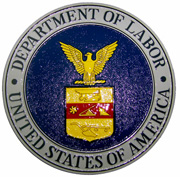LOCAL
Union membership gains; Washington ranks 4th
 WASHINGTON, D.C. (Jan. 27, 2014) — The number of workers in unions in 2013 rose by 162,000, with the increase of 281,000 workers in private-sector unions offset by the decrease of 118,000 public-sector union members, according to data released Friday by the U.S. Bureau of Labor Statistics (BLS). Strong gains in construction and manufacturing jobs were offset by what the AFL-CIO called “politically motivated layoffs of public-sector workers” last year. Said AFL-CIO President Richard Trumka:
WASHINGTON, D.C. (Jan. 27, 2014) — The number of workers in unions in 2013 rose by 162,000, with the increase of 281,000 workers in private-sector unions offset by the decrease of 118,000 public-sector union members, according to data released Friday by the U.S. Bureau of Labor Statistics (BLS). Strong gains in construction and manufacturing jobs were offset by what the AFL-CIO called “politically motivated layoffs of public-sector workers” last year. Said AFL-CIO President Richard Trumka:
Wall Street’s Great Recession cost millions of America’s workers their jobs and pushed already depressed wages down even further. But in 2013, America’s workers pushed back. At the same time, these numbers show that as unorganized workers have taken up the fight for their right to a voice on the job, union employers are hiring — creating good jobs our economy desperately needs.
Washington state posted a strong increase of 106,000 total jobs in 2013 with union membership increasing by 33,000 members. In the state-by-state breakdown, Washington ranked No. 4 in terms of union density in 2013, with the state’s 546,000 union members accounting for 18.9% of the overall workforce — nearly one in five Washington workers – up from 18.5% the previous year. Only New York (24.4%), Alaska (23.1%) and Hawaii (22.1%) and have higher unionization rates than Washington. Neighboring Oregon ranks 12th in union density (13.9%).
See the BLS news release on the new report and its state-by-state comparison.
 “Thanks to our positive business climate and its strong unions, Washington state continued to add jobs and union members in 2013,” said Jeff Johnson, President of the Washington State Labor Council, AFL-CIO. “But we know that many more workers — from fast-food employees to airport contractors to low-wage retail workers — would form unions tomorrow if labor laws properly protected their rights. Although it’s illegal for employers to coerce, threaten and fire workers who support unionization, those laws are not enforced and it happens routinely, particularly in the private sector. Unions in Washington will continue to lead the charge to help people exercise their freedom of association at work and their freedom to unionize for better wages and working conditions. We know we all do better when we all do better.”
“Thanks to our positive business climate and its strong unions, Washington state continued to add jobs and union members in 2013,” said Jeff Johnson, President of the Washington State Labor Council, AFL-CIO. “But we know that many more workers — from fast-food employees to airport contractors to low-wage retail workers — would form unions tomorrow if labor laws properly protected their rights. Although it’s illegal for employers to coerce, threaten and fire workers who support unionization, those laws are not enforced and it happens routinely, particularly in the private sector. Unions in Washington will continue to lead the charge to help people exercise their freedom of association at work and their freedom to unionize for better wages and working conditions. We know we all do better when we all do better.”
U.S. Secretary of Labor Thomas Perez said the BLS figures again show that union members continue to have higher weekly median earnings than nonunion workers — $950 a week compared to $750 a week. He said union members also have greater access to health care, retirement savings plans, sick and vacation leave than workers who don’t have a union on the job. Said Perez:
Workers’ ability to form unions and engage in collective bargaining has been a cornerstone of a strong middle class. The decline in union membership over the last few decades has contributed to more working families struggling to get by. When workers have a seat at the table, they are better able to bargain for their fair share of the value they helped create; and that leads to greater economic security and economic mobility for everyone. As our economy continues to recover and we work to create good jobs, we need to ensure workers can lift their voices to raise wages, reduce inequality and help more people climb ladders of opportunity.
For more information about joining a union, click here.
AFL-CIO Now contributed to this report.





